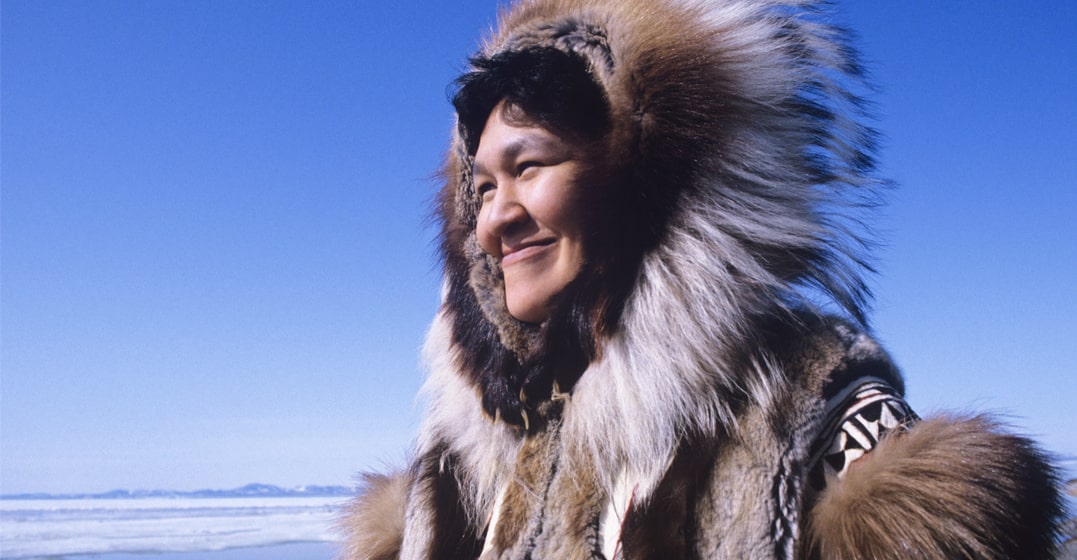Updated on January 9, 2024

Get to know the Inuit languages

Have you ever heard of the Inuit languages? Since they have such a small number of speakers worldwide, maybe they’ve just never been on your radar.
But this group of indigenous languages, with its deep roots and complex grammatical structure, is definitely worth learning more about.
Below, we discuss Inuit languages, including what they are, where they’re spoken (and by whom) and some of their linguistic features. We also go through some words and phrases for you to learn.
The “Inuit” is a group of languages—five, to be specific: Inuvialuktun, Inuinnaqtun, and three different dialects of Inuktitut. These languages are spoken by the Inuit indigenous groups of Canada, Alaska and Greenland. There’s also a small Inuit-speaking Greenlandic population in Denmark.
It’s hard to tally the exact number of Inuit speakers, but in total, around 110,000 people speak an Inuit dialect globally. There are about 57,000 speakers in Greenland and Denmark, around 34,000 in Canada and approximately 19,000 in Alaska.
According to Statistics Canada, the largest population of Inuit speakers is in Nunavik, which is in the northern portion of the Canadian province of Québec, with almost 100% of the Inuit population saying they’re fluent. After that, it’s the Canadian territory of Nunavut, with 89%.
The terminology can get a little confusing, so let’s clear it up! First of all, as we mentioned above, Inuit is a word that refers to a group of five indigenous spoken by the Inuit people. The actual name for that group of languages is Inuktut. Within that group of five languages, as we mentioned above, is a language called Inuktitut.
With three different dialects, the Inuktitut language is, by far, the most common Inuit (or Inuktut)—about 56% of all Inuit people report being able to speak it. This language is spoken by Eastern Canadian Inuit groups in areas including Québec, Nunavut, Newfoundland and Labrador. It’s also spoken in Greenland and Denmark.
There are several differences between Inuit dialects. Here are some key characteristics of Inuit languages, largely focused on Inuktitut rules, as it’s the most widely spoken.
There are three basic vowels in almost all Inuit languages: i, a and u. As in many languages, vowel sounds can either be short or long, and the length affects the meaning of the word. In some dialects, such as those spoken in Nunavut, you’d denote a long vowel sound by writing it as a double vowel. There will never be more than two vowels in a row.
The number of consonants varies depending on the dialect. In the Nunavut dialects, for example, there are 15 consonants.
In Inuktitut, words can only begin with the consonants i, u, a, p, t, k, m, n, s or q. They can only end with i, u, a, p, t, k and q.
Most consonants can be doubled, which changes the meaning of a word. Consonant clusters are never longer than two consecutive letters.
While Inuit nouns have no gender markers, they do have number markers—singular, dual and plural in most dialects. They also have at least eight cases.
In languages such as Inuktitut, verbs always express the subject person; sometimes, they also express the object person. Therefore, there are two types of verb endings: one-person and two-person. Verbs also express mood. Some dialects have up to ten different moods, indicating a fact, a question, a command, etc.
Like English verbs, many Inuit languages have past, present and future tenses. These are determined by how long ago something happened or how far in the future something will happen.
Interested in learning some Inuktitut words? Here are a few to get you started:
| English | Inuktitut |
| It is snowing | Kannijuk |
| I love you | Nalligivagit |
| How are you? | Qanuipit? |
| I am happy | Quviasuktunga |
| Thank you | Qujannamiik |
| Yes | li |
| No | aakka, aagaa |
| Snow | aniu, apijaq, aput, isiriartaq, katakartanaq, kavisilaq, kinirtaq, mannguq, masak, matsaaq, natiruvaaq, pukak, qannialaaq, qanik, qiasuqaq, qiqumaaq |
Has our discussion of Inuit languages piqued your interest? Although these five languages aren’t spoken by many people, they’re incredibly interesting, culturally important and complex. Take some time to learn more about the geography, grammar and vocabulary of Inuit languages—you won’t regret it!